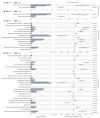Effect of Vitamin A Supplementation on Growth Performance, Serum Biochemical Parameters, Intestinal Immunity Response and Gut Microbiota in American Mink (Neovison vison)
- PMID: 34071204
- PMCID: PMC8229402
- DOI: 10.3390/ani11061577
Effect of Vitamin A Supplementation on Growth Performance, Serum Biochemical Parameters, Intestinal Immunity Response and Gut Microbiota in American Mink (Neovison vison)
Abstract
This experiment investigated the effect of vitamin A supplementation on growth, serum biochemical parameters, jejunum morphology and the microbial community in male growing-furring mink. Thirty healthy male mink were randomly assigned to three treatment groups, with 10 mink per group. Each mink was housed in an individual cage. The mink in the three groups were fed diets supplemented with vitamin A acetate at dosages of 0 (CON), 20,000 (LVitA) and 1,280,000 IU/kg (HVitA) of basal diet. A 7-day pretest period preceded a formal test period of 45 days. The results show that 20,000 IU/kg vitamin A increased the ADG, serum T-AOC and GSH-Px activities, villus height and villus height/crypt depth ratio (p < 0.05). The mRNA expression levels of IL-22, Occludin and ZO-1 in the jejunum of mink were significantly higher in the LVitA group than those in the CON and HVitA groups (p < 0.05). Vitamin A supplementation increased the diversity of jejunum bacteria, decreased the ratio of Firmicutes to Bacteroidetes and increased the relative abundance of Akkermansia, uncultured bacterium f Muribaculaceae, Allobaculum, Lachnospiraceae NK4A136 group, Rummeliibacillus and Parasutterella. The comparison of potential functions also showed enrichment of glycan biosynthesis and metabolism, transport and catabolism pathways in the vitamin A supplementation groups compared with the CON group. In conclusion, these results indicate that dietary vitamin A supplementation could mediate host growth by improving intestinal development, immunity and the relative abundance of the intestinal microbiota.
Keywords: Akkermansia; IL-22; growth performance; mink; villus height; vitamin A.
Conflict of interest statement
The authors declare no conflict of interest.
Figures






Similar articles
-
Dietary supplementation with Cyberlindnera jadinii improved growth performance, serum biochemical Indices, antioxidant status, and intestinal health in growing raccoon dogs (Nyctereutes procyonoides).Front Microbiol. 2022 Sep 21;13:973384. doi: 10.3389/fmicb.2022.973384. eCollection 2022. Front Microbiol. 2022. PMID: 36212816 Free PMC article.
-
Effect of low dosage of chito-oligosaccharide supplementation on intestinal morphology, immune response, antioxidant capacity, and barrier function in weaned piglets.J Anim Sci. 2015 Mar;93(3):1089-97. doi: 10.2527/jas.2014-7851. J Anim Sci. 2015. PMID: 26020885
-
Effects of Dietary Yucca Schidigera Extract and Oral Candida utilis on Growth Performance and Intestinal Health of Weaned Piglets.Front Nutr. 2021 May 26;8:685540. doi: 10.3389/fnut.2021.685540. eCollection 2021. Front Nutr. 2021. PMID: 34124128 Free PMC article.
-
Effects of dietary vitamin E supplementation on the reproductive performance of yearling female mink (Neovison vison) fed wet fish-based feed.Anim Reprod Sci. 2020 Feb;213:106270. doi: 10.1016/j.anireprosci.2019.106270. Epub 2019 Dec 28. Anim Reprod Sci. 2020. PMID: 31987323
-
Bacteriophage as an Alternative to Antibiotics Promotes Growth Performance by Regulating Intestinal Inflammation, Intestinal Barrier Function and Gut Microbiota in Weaned Piglets.Front Vet Sci. 2021 Jan 27;8:623899. doi: 10.3389/fvets.2021.623899. eCollection 2021. Front Vet Sci. 2021. PMID: 33585620 Free PMC article.
Cited by
-
Colitis-Mediated Dysbiosis of the Intestinal Flora and Impaired Vitamin A Absorption Reduce Ovarian Function in Mice.Nutrients. 2023 May 23;15(11):2425. doi: 10.3390/nu15112425. Nutrients. 2023. PMID: 37299390 Free PMC article.
-
Nutraceuticals for Complementary Treatment of Multisystem Inflammatory Syndrome in Children: A Perspective from Their Use in COVID-19.Life (Basel). 2022 Oct 20;12(10):1652. doi: 10.3390/life12101652. Life (Basel). 2022. PMID: 36295088 Free PMC article. Review.
-
Manipulation of the diet-microbiota-brain axis in Alzheimer's disease.Front Neurosci. 2022 Nov 4;16:1042865. doi: 10.3389/fnins.2022.1042865. eCollection 2022. Front Neurosci. 2022. PMID: 36408394 Free PMC article. Review.
-
Effects of Dietary Vitamin A on the Growth Performance, Nonspecific Immune Response, Shell Microbiota and Red Spotted Disease Resistance of Juvenile Sea Urchin (Strongylocentrotus intermedius).Aquac Nutr. 2025 Feb 7;2025:3601517. doi: 10.1155/anu/3601517. eCollection 2025. Aquac Nutr. 2025. PMID: 39958704 Free PMC article.
-
Dietary supplementation with Cyberlindnera jadinii improved growth performance, serum biochemical Indices, antioxidant status, and intestinal health in growing raccoon dogs (Nyctereutes procyonoides).Front Microbiol. 2022 Sep 21;13:973384. doi: 10.3389/fmicb.2022.973384. eCollection 2022. Front Microbiol. 2022. PMID: 36212816 Free PMC article.
References
-
- Sirisinha S. The pleiotropic role of vitamin A in regulating mucosal immunity. Asian Pac. J. Allergy Immunol. 2015;33:71–89. - PubMed
Grants and funding
LinkOut - more resources
Full Text Sources

